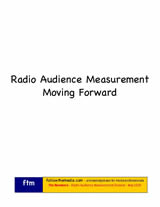
| The Numbers |
 |
followthemedia.com - a knowledge base for media professionals |
|
|
KNOWLEDGE
 Measuring audiences; includes electronic measurement systems and device descriptions, mobile media, RAJAR (UK) debate, with comments. AGENDA
|
||
UK Radio Relieved That Summer is OverSummer radio surveys are always the pits. Programmers know that listeners are distracted by, well, summer. And managers don’t want to waste the marketing budgets when nobody is around.
The first bit of good news is due the commercial broadcasters. Overall aggregate shares (persons 15 years and older) for national and local commercial channels are up. National commercial channels’ shares are the highest in three years: 10.9%. Local commercial stations are the highest this year: 32.6%, down from 33% in Q3 2005. As audience share is part of the whole, the BBC must be down. Total BBC audience share is 54.3%, lowest since Q2 2005. This would be the second bit of good news for commercial broadcasters and not so good for the BBC. But BBC national channels are up: 44.5%, the highest in three years. It was BBC local channels taking it on the short side, down to 9.8% from 10.7% one year on.
The KISS national network now ties Virgin Radio for 10th place nationally. Kiss increased audience share 0.4% one year on to 1.5%. Beneath the top10, XFM moved up to 0.8% from 0.5% year on year. There were no major share losers among the national commercial channels, all generally maintained share and position. Not so good over at the BBC, though, as BBC Radio 2 - still top ranked nationally – fell 0.4% from Q3 2005 to 15.2%. Radio 2 has a bad history with summer audience surveys. Five Live also fell 0.4% to 4.2%. Both up and down is Radio 1: up to 9.8% from 9.4% one year on but down from 10.3% in Q2. BBC 4, however, is up to 11.8%, number 2 in the national survey. If the UK national radio survey looks boringly consistent the London survey – where the ad buyers live – is far more exciting, in a very controlled way. Except for BBC national channels: Radio 4 now has a 16.1% market share in London, up 0.7% one year on and 3.0% quarter to quarter. Radio 2 and Radio 3 are both up a smidge but Radio 1 took it in the dumper, down to 5.3% from 5.8% one year on. Five Live is down in London as well as nationally. On the commercial radio side, which gets all the weighty analysis in the London press, things are as they seem: up and down. Most of the blathering has been about the precipitous fall of Capital Radio, flagship of GCap, the second most misunderstood radio station in the UK. First, of course, is TalkSport. Capital Radio’s London market share in now 4.7%, falling faster than Tony Blair’s popularity. But the new programmer has barely found the keys to the executive washroom. But it was summer. But the marketing campaign hasn’t kicked in. But the breakfast show is still the biggest in London. Add to that, GCap’s Classic FM is up in London, to 4.5% market share. Capital Gold is also up in London. Why, then, did the stock traders punish GCap? The simple answer is “Because they want to.” So now, with Capital Radio on the skids, there’s the quarterly battle between Heart and Magic. Heart wins this one by losing 0.3% market share year on year, now 6.1%, same as last quarter. Magic seems to be settling into to 5% range (5.3% in the Q3 survey), nose - diving from a 7% in Q1. The two biggest winners in the summer quarter survey were talk station LBC 97.3 and hip hop Choice FM. LBC’s “Real Life, Real London” campaign aims straight for the 30 to 45 year olds, the folks deserting Capital Radio. Choice FM is just, plain hot but that was summer-time. Not to be overlooked is the Rajar-revelation that digital radio in the UK took a pause during the summer. The percentage of homes with DAB receivers did not continue its projected trajectory. Listening via the internet or TV set top box was down. There’s no question that digital radio in the UK passed through the early adopters long ago. Only a week before the RAJAR data release the Digital Radio Development Bureau forecast that in four (short) years digital radio will be in half of UK households. While the DRDB forecast might be ambitious it’s likely not far from accurate. |
| copyright ©2004-2006 ftm partners, unless otherwise noted | Contact Us • Sponsor ftm |